Jesters in Mythology
It’s not only in modern tales that the jester archetype makes an appearance. Looking back to ancient myths and legends there are plenty of tricksters and jokesters to be found.
The archetype of the jester is a universal and enduring character that appears in various cultural and literary traditions. The jester is typically depicted as a comedic and entertaining figure, known for their wit, humour, and often mischievous behaviour.
The jester archetype embodies the duality of light-heartedness and insight, reminding us of the power of laughter and the value of questioning established conventions.
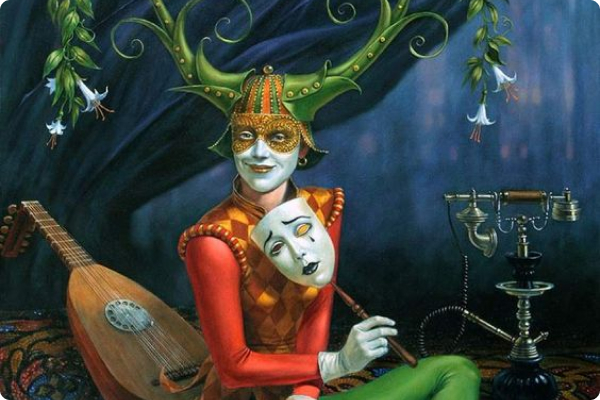
From Sadness to Joy | Michael Cheval
Myths and Archetypes in Ancient Greece
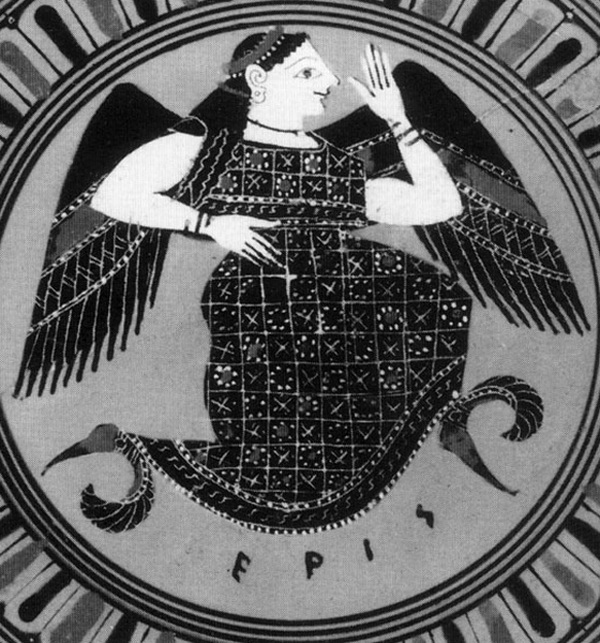
Eris | Antikensammlung Berlin
Greek mythology offers a treasure trove of stories featuring the jester archetype, with several other fascinating characters that embody their mischievous spirit. One such example is Pan, the half-human, half-goat deity known for his merry disposition. Pan’s playful nature and infectious laughter could often be heard echoing through the forests and mountains, entertaining both gods and mortals alike.
Another prominent jester-like figure from Greek Myths, is Eris, the goddess of discord. Eris delighted in sowing chaos and mischief among the gods by initiating the events that led to the Trojan War, earning her a reputation as a cunning and unpredictable trickster.
Additionally, the satyrs, mythical creatures with the upper body of a man and the lower body of a goat, often fulfilled the role of jesters in Greek mythology. Known for their love of revelry, music, and dance, satyrs, such as Silenus and Marsyas, entertained gods and humans with their comedic antics and lively performances.
Hermes, the messenger of the gods, also displayed jester-like qualities in Greek mythology. Known for his cleverness and quick wit, Hermes often played pranks on the other gods, engaging in playful banter, and using his cunning to outsmart adversaries. One of his notable pranks involved stealing Apollo’s cattle and inventing the lyre, which he presented as a peace offering to appease the angered god.
In other myths, Autolycus, a master thief known for his cunning and skillful deceit. Autolycus possessed a sharp sense of humour and a knack for transforming situations into comedic chaos. He would often employ clever tricks and wordplay to outsmart his opponents, leaving them bewildered and amused by his antics.
Another jester-like figure is Hephaestus, the god of blacksmiths and craftsmanship. Although not traditionally associated with jesters, Hephaestus displayed a wry sense of humour and a penchant for practical jokes. His playful side was particularly evident in the myth where he devised an elaborate trap to catch his unfaithful wife, Aphrodite, and her lover, Ares, in the act of their affair. It was said that the whole of Olympus roared with laughter to witness the scene (Cartwright and Jastrow)
Furthermore, the nymph Echo, though not explicitly a jester, had a mischievous spirit and a propensity for wordplay. Echo was cursed to only repeat the last words she heard, which often led to humorous and chaotic situations. Her playful nature and witty responses added a touch of humour to various mythological encounters.
The jester archetype can also be seen in the character of Dionysus, the god of wine, revelry, and theatre. Dionysus was known for his extravagant celebrations, where jesters and performers entertained him and his followers with their comedic acts, music, and dance. These festivities, known as Dionysian festivals, celebrated the joy and chaos that came with indulging in wine and uninhibited revelry.
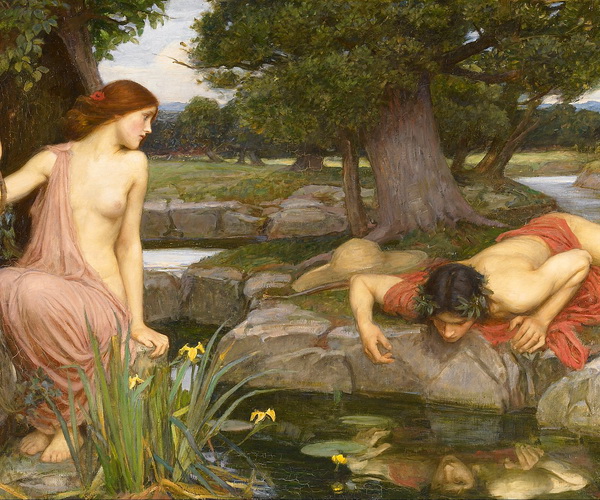
Echo and Narcissus | John William Waterhouse
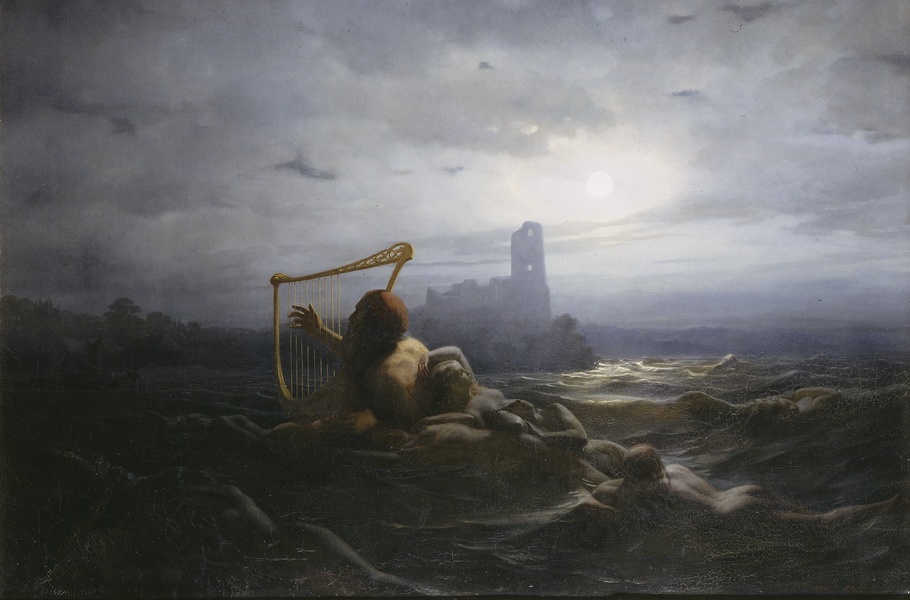
The Water-Sprite and Ägir’s Daughters | Nils Blommér (1850)
Norse Mythological Archetypes
While Norse mythology is renowned for its epic battles and powerful gods, it also features some fascinating figures who embody the jester archetype. One such character is Loki, the trickster god and shapeshifter. Loki’s mischievous nature often led him to play pranks and engage in clever wordplay, bringing both laughter and chaos to the realm of the gods. His antics included transforming into different forms, creating humorous disturbances, and outwitting his fellow deities with his cunning wit. His antics included changing his sex and shape, creating humorous disturbances, and outwitting his fellow deities with his cunning wit (The Editors of Encyclopaedia Britannica, “Loki | Mythology, Powers, and Facts”)
Another jester-like figure in Norse mythology is Ægir, the god of the sea and brewing. Ægir was known for hosting extravagant feasts for the gods, where he entertained them with his jovial personality, amusing stories, and unlimited supply of ale. His gatherings were renowned for their festive atmosphere, with jesters and entertainers adding to the merriment through their comedic performances.
Additionally, the Norse mythological creatures known as the dwarves exhibited jester-like qualities. These diminutive beings were skilled craftsmen but were also known for their playful nature and witty remarks. They often engaged in banter and practical jokes, using their cleverness to bring laughter to both gods and mortals.
It is worth mentioning that while the jester archetype is present in Norse mythology, it may not be as prevalent or emphasised as in other mythological traditions. Norse mythology tends to focus more on heroic quests and cosmic battles, but the mischievous and humorous elements brought by characters like Loki and Ægir provide a refreshing contrast and add depth to the mythological narratives.
Asian Mythological Archetypes
Asian myths encompass a wide array of cultures and traditions, each with their own unique narratives and characters. While the jester archetype may not be as prominently featured in Asian myths as in Western mythology, there are still notable figures that embody elements of wit, humour, and trickery.
In Chinese mythology, one character that showcases jester-like qualities is the mischievous monkey deity known as Sun Wukong, or the Monkey King. Sun Wukong, featured prominently in the classic Chinese novel “Journey to the West,” is known for his cleverness, playful nature, and propensity for causing chaos (“Sun Wukong – Mythopedia”). With his shapeshifting abilities and remarkable wit, Sun Wukong often outsmarts gods, demons, and mortals alike, leaving a trail of laughter and merriment in his wake.
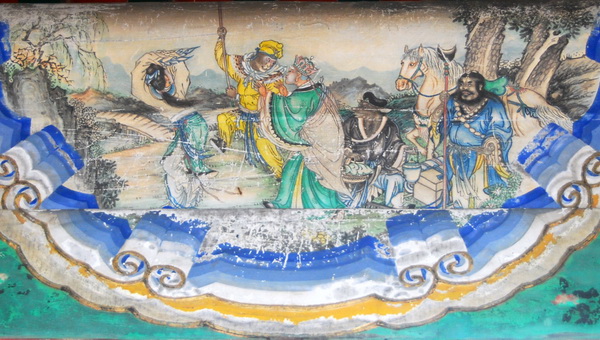
Summer Palace Painting | 19th Century
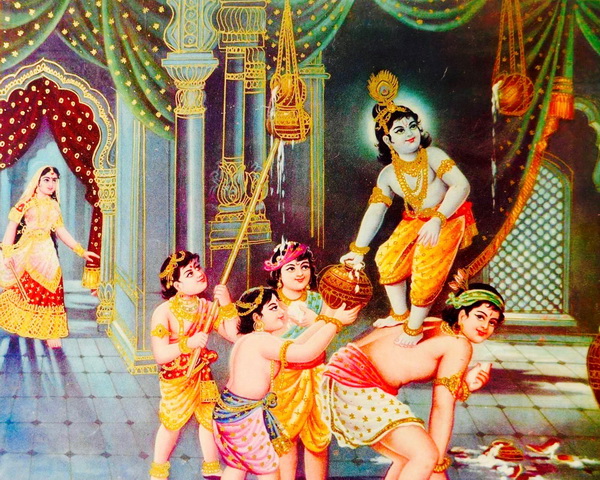
Baby Thief Krishna | Bazaar Art (c. 1950)
In Japanese folklore, there is a creature called the Kitsune, a mischievous fox spirit known for its ability to shape-shift and deceive humans. While not exclusively a jester, the Kitsune displays cunning and playful tendencies, often engaging in pranks and trickery to test the wits of unsuspecting individuals. These antics add an element of humour and unpredictability to the folktales in which they appear.
Furthermore, in Indian mythology, the god Krishna is often depicted as a playful and mischievous figure during his youth. Known for his charming smile and clever escapades, Krishna’s pranks, such as stealing butter or playing tricks on villagers, embody the spirit of a jester-like character, spreading joy and laughter wherever he goes.
While the jester archetype may manifest differently in Asian myths compared to Western mythology, the presence of characters like Sun Wukong, Kitsune, and Krishna highlights the universality of humour, trickery, and the role of jesters in bringing joy and levity to traditional tales. These characters add a touch of whimsy and entertainment to the diverse tapestry of Asian myths, captivating audiences with their cleverness and playful nature.
Within Aboriginal Australian cultures, the Mimi spirits are known for their playful nature and love of pranks. These long-limbed, spirit-like beings inhabit the rocky landscapes of the Northern Territory and are believed to be responsible for unusual occurrences and unexplained phenomena. It is also said that the Mimi once taught the Aboriginal people how to hunt and cook when they first came to northern Australia (Linklater).
The Mimi spirits’ mischievous actions add an element of humour and intrigue to Aboriginal Australian mythology.
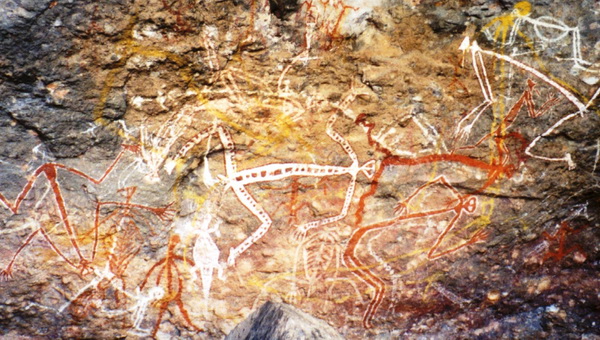
Mimi Spirits | Anbangbang Gallery
Māori Mythology and Archetypes
Maori mythology is the traditional belief system of the indigenous Maori people of New Zealand. It is a fascinating and intricate mythology that is deeply intertwined with the natural world and ancestral spirits. While there may not be a specific jester archetype, there are elements within Maori mythology that reflect humour, cleverness, and mischievousness.
One prominent figure in Maori mythology is Māui, a demigod known for his trickster-like qualities. Māui is often depicted as a cunning and mischievous character, known for his playful and audacious exploits. He is renowned for his cleverness, quick thinking, and his ability to outsmart powerful beings. Through his antics and adventures, Māui brings laughter, excitement, and a touch of irreverence to Maori mythological narratives.
One well-known story featuring Māui is the tale of how he snared the sun. Māui devised a plan to slow down the sun’s journey across the sky by capturing it in ropes. By strategically positioning himself and his brothers, Māui managed to ensnare the sun, allowing for longer days and creating more time for people to work and enjoy their activities. This tale highlights Māui’s cleverness, as well as his willingness to challenge the natural order of things for the benefit of humanity.
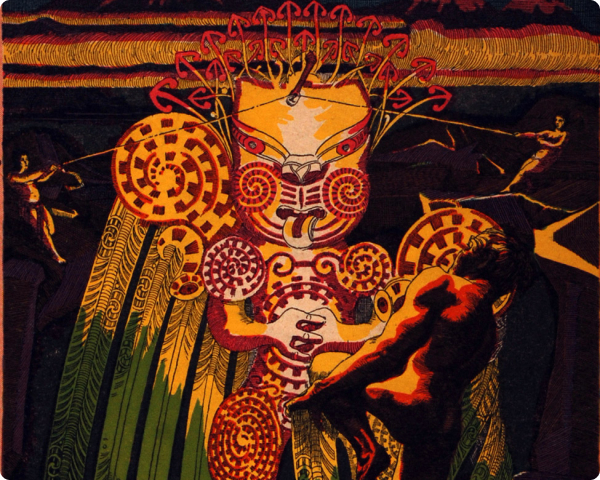
Maui | A.W. Reed (1943)
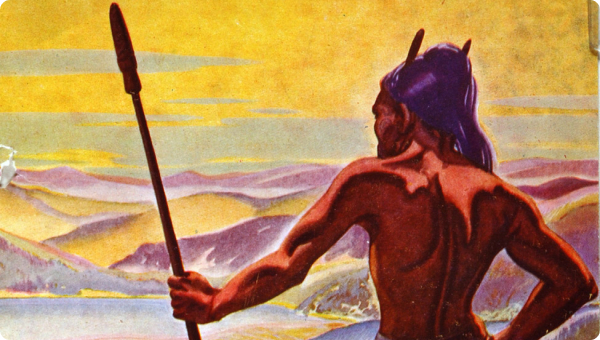
Myths and Legends of Maoriland | A.W. Reed
Māui is also credited with discovering and fishing up the North Island of New Zealand, known as Te Ika-a-Māui (The Fish of Māui). In this story, Māui uses his wit and resourcefulness to convince his brothers to help him sail out into the ocean and fish up the great landmass. Through his cleverness and determination, Māui plays a pivotal role in shaping the landscape of New Zealand, showcasing his mischievous and transformative nature.
Māui is often depicted as a character who brings humour and lightheartedness to various mythological narratives. His quick wit, cunning schemes, and his ability to navigate challenges with a humorous twist make him an engaging and entertaining figure within Maori mythology.
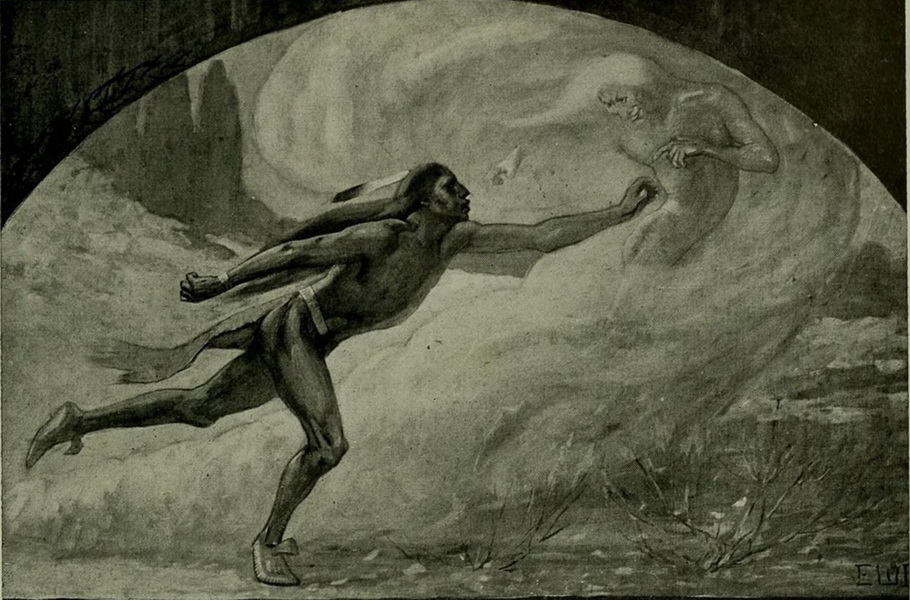
Nanabozho chasing the spirit of Mischief | E..W. Deming (1900)
Native American Mythological archetypes
Native American mythology is a vast tapestry of diverse cultures and tribes, each with their own unique trickster figures. While Coyote is a prominent trickster in many Native American traditions, another well-known jester-like character is Raven. Raven is often depicted as a shapeshifter and a mischievous trickster who brings laughter and plays pranks on both animals and humans. With his cunning and wit, Raven frequently disrupts the natural order of things, challenging social norms and providing valuable lessons through his humorous actions.
Similarly, in various Algonquian and Ojibwe tribes, Nanabozho is a legendary figure who embodies the jester archetype. Nanabozho, also known as Nanabush, is a shape-shifting spirit or deity with transformative abilities (Nanabozo). He is known for his humorous antics, such as exaggerating stories, engaging in comical situations, and teaching lessons through laughter. Nanabozho challenges societal conventions, subverts expectations, and uses his wit to navigate the world, all while bringing a sense of humour to Native American mythology.
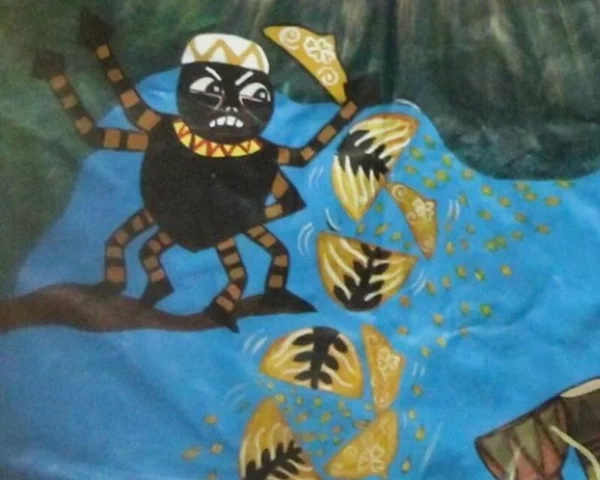
Turning to African mythology, trickster figures abound across the continent, each with their own distinct characteristics and roles. Anansi the Spider is one of the most renowned tricksters in West African folklore. Often portrayed as a cunning and clever character, Anansi uses his wit and trickery to outsmart more powerful beings and navigate challenging situations. Anansi’s tales not only entertain but also carry moral lessons, teaching about the consequences of greed, selfishness, and foolishness.
In Yoruba mythology, Eshu is a prominent trickster deity associated with communication, fate, and the crossing of boundaries. Eshu possesses a sharp intellect, employing his wit and cleverness to both create and solve problems. His mischievous nature challenges social norms and exposes human weaknesses, reminding individuals of the importance of wit and adaptability. His shrines would often receive offerings of cowrie shells or money in order to convince him to act as a messenger rather than play tricks (Cromwell).
Myths and Archetypes in Ancient Egypt
While Egyptian mythology is known for its grandiose gods and epic tales, like other cultures, there are intriguing figures that can be associated with the jester archetype, bringing humour and light-heartedness to the mythological narratives. Although not specifically referred to as jesters, these characters exhibit traits of wit, cleverness, and playfulness.
One example is Bes, a dwarf-like deity who is often depicted as a jovial and comical figure. Bes is associated with laughter, music, and dance, and is believed to protect against evil spirits. His whimsical appearance, with his protruding tongue, dwarf-like stature, and lion-like features, adds a touch of humour to the Egyptian pantheon. Bes was particularly popular during the New Kingdom era, and his image was frequently used as a protective talisman and as a source of amusement.
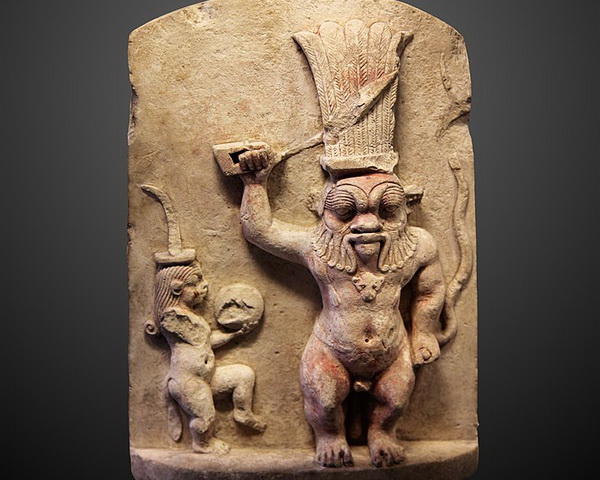
Bes and Beset | Wikipedia
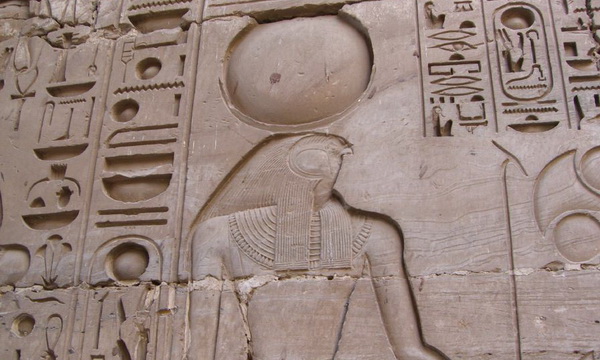
Temple of Khonsu carving | Wikipedia
Another character that can be associated with the jester archetype is Khonsu, the god of the moon and time. Khonsu was often portrayed as a young, playful deity with a mischievous grin. He was considered a trickster who could manipulate time and sway fate. Khonsu’s light-hearted nature and unpredictable behaviour add an element of humour and unpredictability to Egyptian mythology.
Additionally, there are mythological tales that involve humorous or amusing incidents. For example, the myth of the “Destruction of Mankind” involves the goddess Hathor transforming into a lioness to punish humanity. However, the other gods realised that her wrath was too severe, and in an attempt to stop her, they mixed beer with red ochre to create a concoction that resembled blood. When Hathor consumed the mixture, she became intoxicated and her anger subsided, bringing an amusing twist to the story.
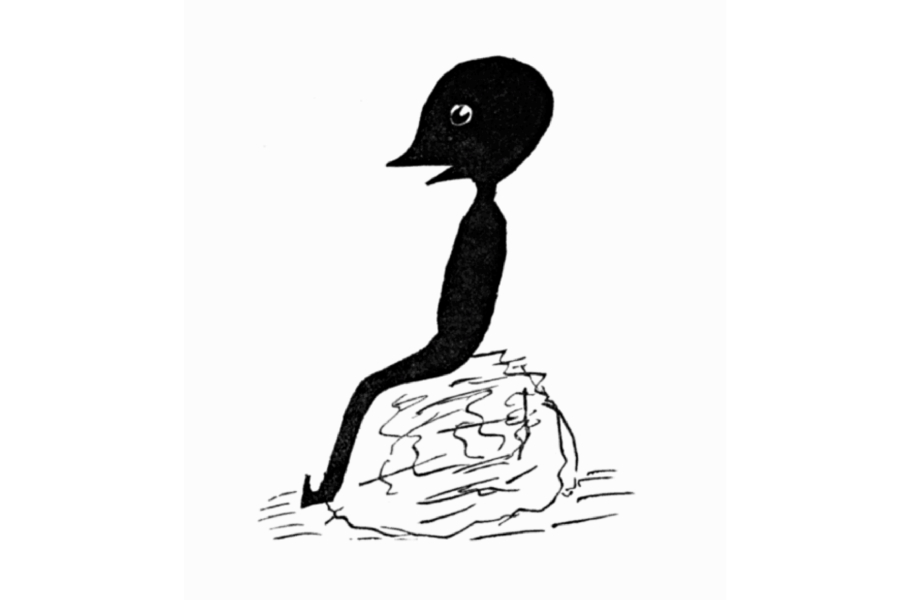
Pwca | Wirt Sikes (1880)
Celtic Myths and Archetypes
Celtic mythology is a vast and rich tapestry of folklore, legends, and deities that spanned across the Celtic regions of Ireland, Scotland, Wales, and other parts of Western Europe. While the Celtic tradition does not have a specific jester archetype, there are figures and creatures within Celtic mythology that exhibit humorous and mischievous qualities.
One notable character in Celtic mythology is the leprechaun, often associated with Irish folklore. Leprechauns are small, solitary beings who are known for their mischievous nature and their penchant for playing pranks on unsuspecting humans. These trickster-like creatures are often depicted as wearing green clothing, making shoes, and guarding their pots of gold at the end of the rainbow. Leprechauns embody the playful and elusive spirit of jesters, delighting in their clever tricks and riddles.
Another figure from Celtic mythology that possesses mischievous qualities is the Puca. The Puca is a shapeshifting creature known in Irish and Welsh folklore. It can appear as a horse, a goat, a hare, or even a human-like figure. The Puca is known for its ability to cause confusion, frighten travellers, and play tricks on unsuspecting individuals (Rainbolt). While not explicitly a jester, the Puca’s trickster nature adds an element of unpredictability and humour to Celtic mythology.
Furthermore, in Celtic mythology, there are tales of clever heroes and warriors who display wit and humour in their exploits. Characters such as Cu Chulainn from Irish mythology and Taliesin from Welsh mythology often employ their quick thinking and humorous banter to outsmart their opponents or navigate challenging situations. Their cleverness and humorous remarks contribute to the lighthearted and entertaining aspects of Celtic myths and legends.
Additionally, Celtic mythology is filled with humorous anecdotes, witty dialogues, whimsical creatures, and general amusement that brings joy and laughter to any readers. Whether it’s the tales of mischievous fairies, playful tricksters, or clever heroes, Celtic mythology weaves a vibrant tapestry of characters and narratives that capture the essence of humour, wit, and trickery.
Across the world, there are countless representations of the jester archetype, from ancient times to the Middle Ages. Throughout human history, people have always related to the jester and the symbology behind these enigmatic characters. From representing the light-hearted side of the human condition, to displaying the collective unconscious of the trickster character, we can all learn something from the clever jester.
Resources:
- Cartwright, Mark, and Jastrow. “Hephaistos.” World History Encyclopedia, Mar. 2023, www.worldhistory.org/Hephaistos
- The Editors of Encyclopaedia Britannica. “Autolycus | Trickster, Thief, Odysseus.” Encyclopedia Britannica, 20 July 1998, www.britannica.com/topic/Autolycus.
- Loki | Mythology, Powers, and Facts.” Encyclopedia Britannica, 29 June 2024, www.britannica.com/topic/Loki.
- “Sun Wukong – Mythopedia.” Mythopedia, mythopedia.com/topics/sun-wukong.
- Linklater, Scott. “Mimi Spirits.” Artlandish Aboriginal Art, 22 May 2022, www.aboriginal-art-australia.com/aboriginal-art-library/mimi-spirits.
- “Nanabozo.” The Canadian Encyclopedia, www.thecanadianencyclopedia.ca/en/article/nanabozo.
- Cromwell, Sara. “Yoruba Eshu Figure – Timothy S. Y. Lam Museum of Anthropology.” Timothy S. Y. Lam Museum of Anthropology, 20 June 2024, lammuseum.wfu.edu/2022/12/yoruba-eshu-figure.
- “Khonsu | Egyptian Moon God, Mythology, and Depiction.” Encyclopedia Britannica, 20 July 1998, www.britannica.com/topic/Khonsu.
- Rainbolt, Dawn. “Irish Folklore: The Púca.” Wilderness Ireland, 4 Jan. 2023, www.wildernessireland.com/blog/irish-folklore-puca.

